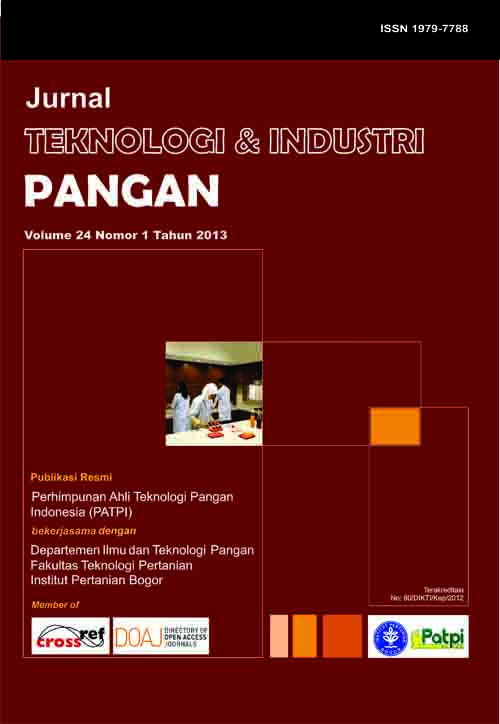ISOLATION AND IDENTIFICATION OF MICROORGANISMS DURING SPONTANEOUS FERMENTATION OF MAIZE [Isolasi dan Identifikasi Mikroorganisme pada Fermentasi Spontan Jagung]
Abstract
Maize was traditionally the second most common staple food in Indonesia. Conversion to maize flour has been accomplished to improve its convenience. Traditionally, maize flour is produced by soaking the kernels in water followed by grinding. It was reported that final physicochemical characteristics of the maize flour were influenced by spontaneous fermentation which occurred during soaking. This research aimed to isolate and identify important microorganisms that grew during fermentation thus a standardized starter culture can be developed for a more controlled fermentation process. Soaking of maize grits was conducted in sterile water (grits:water=1:2, w/v) in a closed container at room temperature (±28ºC) for 72 hours. After 0, 4, 12, 24, 36, 48, 72 hours, water and maize grits were sampled and tested for the presence of mold, yeast, and lactic acid bacteria (LAB). Isolates obtained from the spontaneous fermentation were reinoculated into the appropriate media containing starch to observe their amylolytic activity. Individual isolate was then identified; mold by slide culture method, while yeast and LAB by biochemical rapid kits, i.e. API 20C AUX and API CH50, respectively. The number of each microorganism was plotted against time to obtain the growth curve of the microorganisms during spontaneous fermentation. The microorganisms were identified as Penicillium chrysogenum, P. citrinum, A. flavus, A. niger, Rhizopus stolonifer, R.oryzae, Fusarium oxysporum, Acremonium strictum, Candida famata, Kodamaea ohmeri, Candida krusei/incospicua, Lactobacillus plantarum 1a, Pediococcus pentosaceus, L. brevis 1, L. plantarum 1b, and L. paracasei ssp paracasei 3. Four molds and one yeast were amylolytic while none of the LAB was capable of starch hydrolysis. The growth curve suggested that the amylolitic mold and yeast grew to hydrolyze starch during the course of fermentation, while the LABs benefited from the hydrolyzed products and dominated the later stage of the fermentation.

